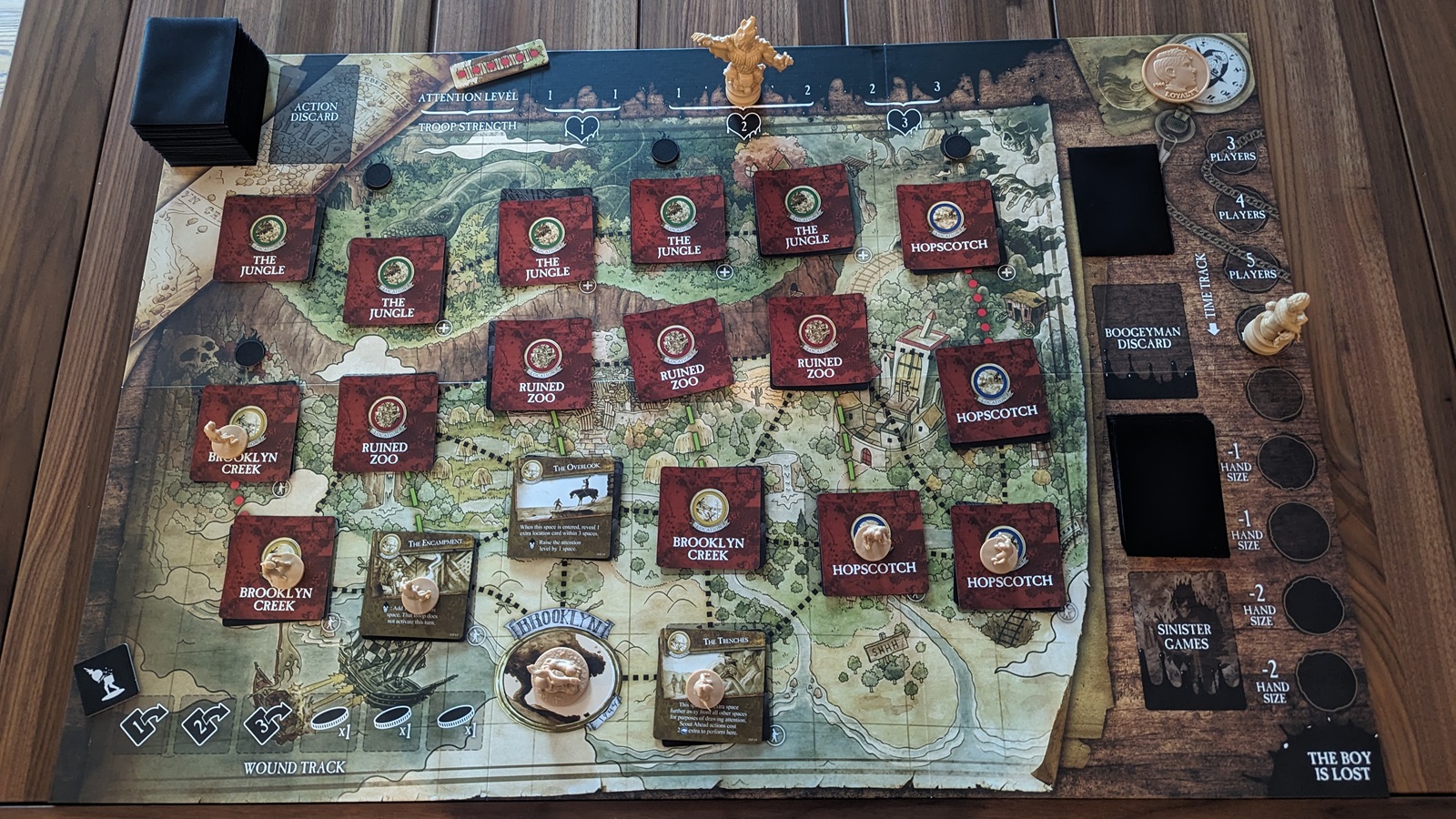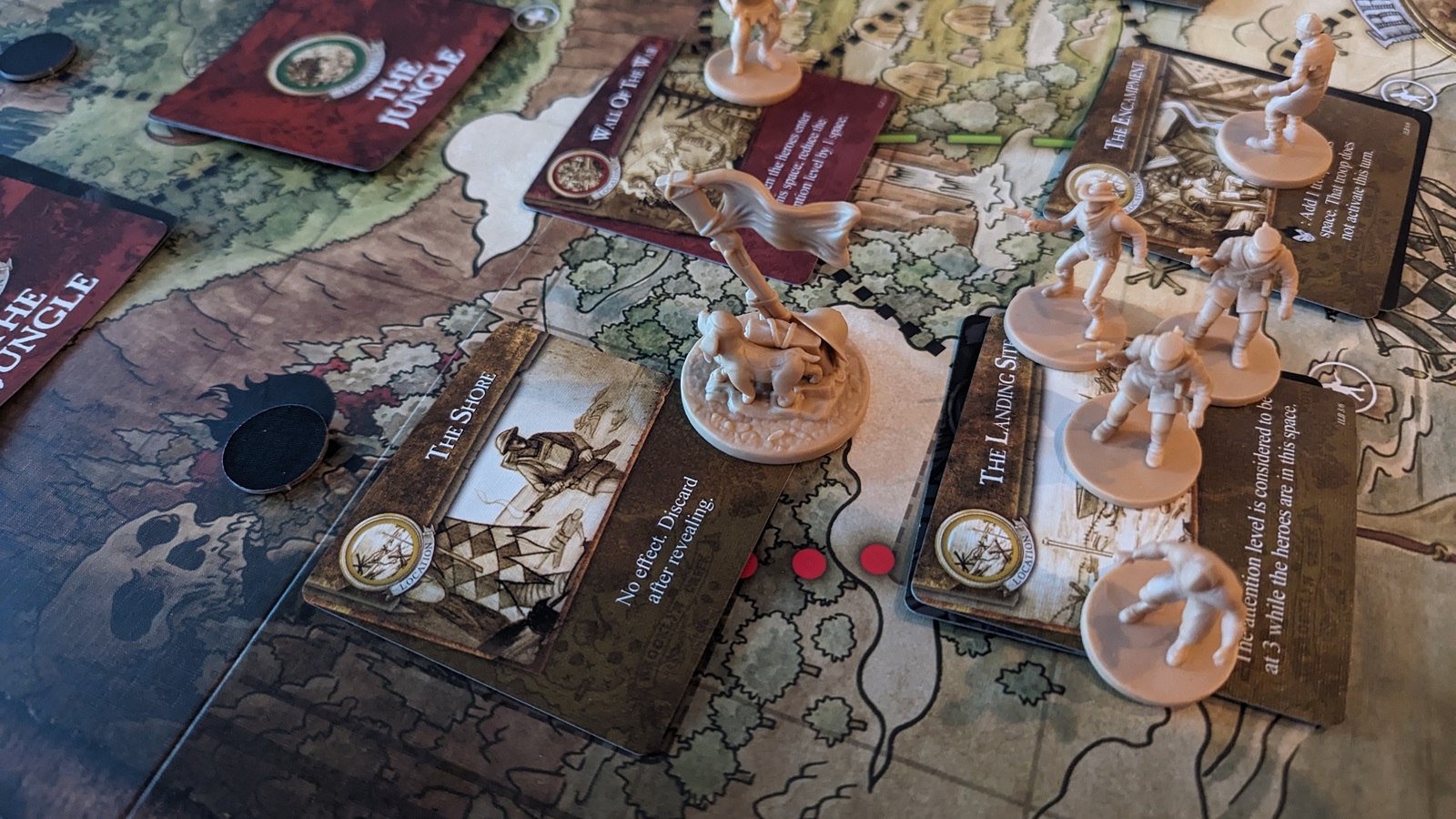I love this game…however, I immediately must communicate that this game isn’t for everyone. The Stuff of Legend is a hidden traitor game for up to six players and it might be my new favorite of the genre. Even with that said, it struggles to be my first pick for a hidden traitor game because it is one of the more difficult hidden traitor games I’ve played. If you’re like me and you love games like Battlestar Galactica or Shadows over Camelot then you should play this game. If not, I understand why this game is not for you. At the very least The Stuff of Legend is a fascinating design that succeeds at what it sets out to do and is worth exploring solely for that.

The Stuff of Legend setup
Overview
The Stuff of Legend is about a band of toys who are attempting to rescue their owner, The Boy, after he is kidnapped by the literal Boogeyman. There are two teams, the toys loyal to The Boy, and the toys loyal to the Boogeyman. At the start of the game one loyalty card for each team is shuffled together with one being placed face down on the board and other card added to the pool of distributed loyalty cards. This creates the hidden traitor part of the game. In five to six player games, there’s the potential for two traitors at the start and in 4 or lower player count games you may not even have an active traitor at the start of the game.
The goal of the toys loyal to The Boy is to find the correct exit somewhere on the map. There are seven tokens with the numbers 1 to 7 and four of them are randomly placed facedown on the four exit spots. The correct exit is the highest number in the game unless both the one and seven are in the game, in which case, one becomes the correct exit. At first this seems convoluted, but it always means that a minimum of two tokens need to be examined for the potential of perfect information. Since this information is so valuable there’s always a sense of uncertainty about which exit is the correct one. The toys loyal to the Boogeyman want the group to either take an incorrect exit or for the “The Boy is Lost” track to reach its final space.
The toys are represented by a marker on the map. The toys always stay together and move as a single unit. Off to the side of the main board is an action board with three spaces. There is no set turn order as a lot of things in the game are resolved as the players determine.

The toys encounter enemy minions and a way to peek at an exit
As for player turns: a player takes an action and signifies they have done so by placing their character standee on an action space. That player takes an action, then after three players have taken an action, the players must activate the Boogeyman’s forces in an order of their choosing. Once that is done, the three characters that have taken actions are placed into the exhausted heroes section of the board. The unexhausted characters are now the only ones who may take an action. This system ensures that each player receives the same number of actions throughout the game.
The actions players take always cost cards. Players begin the game with a hand of seven cards and whenever a player runs out of cards they must flip the Boogeyman’s coin which can either push the The Boy is Lost track one space or draw negative cards from the Boogeyman’s deck. This coin is the timer on which the game runs as even with a 50/50 chance eventually The Boy is Lost track will run out. The actions players may take include: move, hide, play a card for its action, or discard a card to skip their action. Moving always causes the players to vote on the nominated space, preventing any one player from taking the group somewhere the others don’t want to go. Hiding reduces the Boogeyman’s attention track by one space. This track determines how hard enemies are to defeat and how many spaces away enemies activate.
While the two previous actions are important, the core of the game is playing cards for their actions. Cards can be played for an action, or used to boost an action. There are four different skill types of cards: talk, fight, scout, or wild. A player can use the specific action on a card such as fight minions or scout adjacent locations. For their action to be successful the player will need a certain amount of skill icons for that action. That player can further boost their action with more cards of the same type from their hand or ask other players for help with cards from their hands. Further complicating this is that some action cards are “stained” and if these cards are played into an action they will trigger a character’s negative trait. Each character has a positive and negative trait that helps and hinders them throughout the game.

An example of starting components for Max
There are other rules that I haven’t covered such as player’s taking wounds, location abilities, and enemy leader abilities, but I don’t want to try to cover every rule. Just know that the fundamental design of the game is similar to other hidden traitor games where players play cards into a shared pool in order to make actions successful. Other hidden traitor games refer to this as passing checks, but the gameplay is nearly identical. The dwindling cards in everyone’s hands are the ticking clock on the game as each time a player runs out of cards the game gets a little harder for the loyal toys.
Positives and Negatives
Normally I separate out what I think the good and bad of a game’s design is, but here, the things I like might be something you’d loathe. When it comes to hidden traitor games it becomes more subjective as they are more dependent on the people than the mechanisms of the game.
The core of this game is playing cards for their actions and trying to be as successful with those actions as possible. Whether it’s defeating enemies or scouting nearby locations a player will play a card and likely need help from the others to maximize the action’s full potential. Once someone has agreed to help they aren’t under any obligation to actually do so, but usually, players are genuinely trying to help. The game is filled with discussions and speculations about what the current best action is and The Stuff of Legend produced the best discussions I’ve seen in years with players making their case about what they could/want to do. Inevitably, when stalemates occur it also comes down to how the players vote on what to do. As players have varying amounts of trust for each other, temporary alliances form and shift from turn to turn. The heart of any hidden traitor game are the people around the table and The Stuff of Legend created the most tense situations I’ve seen from this type of game and there is a single card responsible for it (we will cover that in a moment). This is incredibly group dependent, but for me, the discussions and accompanying mistrust was the best part of the game. The downside of this is that sometimes the players can get locked into indecision and they will have to vote in order to continue. There could just be too many votes as all the trust at the table had been spent. Who takes an action? Vote. Did that player get voted down and someone else wants to take an action? Vote. Was that approved and that player is trying to move the group? Vote. It is possible for a group to get bogged down trying to figure out the next move, without having useful discussions.
There’s a lot of love in this game, but I have to cover a specific card because it will either make or break the game for you. Other hidden traitor games have separate mechanisms for discovered traitors. Usually this is a way for traitors to reveal so they can play openly, but The Stuff of Legends does not have this. Instead, it has a card called Muddy the Waters. This card allows a player to take another player’s loyalty card, shuffle it with their own, and choose which one to give back to the other player. This card can be used to switch your own team, or another player’s team against their will. If things are looking grim for the loyal toys, you could even jump ship and choose to become a traitor. If you smiled deviously at that thought, this game is for you. If the thought of someone else forcibly changing your team filled you with despair/anger, this game is not for you. A prime example of how this can change a game is that in one of my plays my allegiance was checked and I was a traitor. This was true, and the table believed the player who had checked my card. Unsure on what to do, I spent the next half hour casually threatening to change any player’s allegiance with mine. This sowed enough uncertainty throughout the game that the players struggled to plan ahead. I never actually needed to make good on my promise as eventually The Boy was lost. If you like bluffing and the mind games that accompany hidden traitor games, The Stuff of Legend has the most potential I’ve ever seen. While it has yet to happen in any of my plays, I worry that it’s possible for a player to be shut out of a game if they are determined to be a traitor and that player never draws a Muddy the Water card. While that player would have an even number of actions, it’s likely the others wouldn’t support their action and they may be left with little to do. If this were to happen, it would just be an unfun situation.

Some of the action cards within the game
There’s a hodgepodge of other things that should be mentioned. The Stuff of Legend is a very difficult game for the loyal toys to win. Similar to previous designs (like Shadows over Camelot) depending on how the game goes the traitor(s) may not even have to do anything for the loyal toys to lose. Hidden traitor games are difficult to balance as they are so group dependent, but I do think the difficulty here is as balanced as it could be.
I would only recommend playing The Stuff of Legend at five or six players. As with a lot of hidden traitor games they need a critical mass of people in order to create the air of distrust and uncertainty. As a general rule I don’t recommend any hidden traitor game with fewer than five people and this is no exception.
The artwork is charming and despite knowing nothing about the source material I enjoyed the artwork and flavor text across the game. The main board embodied the perilous journey with a variety of strange locations. The game felt thematic of a group of toys and their desperate struggle across hostile territory.

The toys move toward an exit with enemies in pursuit, but is it the right exit?
The component quality is just ok. The exit tokens are black cardboard and I would worry about them getting marked through use. The same goes for the cards as they are fairly thin and they also should be kept damage free. I would recommend sleeving as much as you can. The plastic coin that is flipped whenever a player runs out of cards is an interesting resolution mechanism for the 50/50 chance, but I would have preferred the game to have a different mechanism. Not everyone is great at flipping a coin and its landing knocked components around more than once. On one occasion it even caused an exit token to flip over when it shouldn’t have. The copy I have came with the optional miniatures for the characters and they are quite nice. Despite their quality, I actually prefer the character standees because of the thematic artwork on them. One detail I enjoy is that there are two sides to each character board: one side as their toy version and the other as the toy sees themself. This small touch, but it helped me think about the character I was playing that game.

Player standees vs. miniatures
An Alternative
This might be weird since I’m recommending The Stuff of Legend, but if all of this sounds like too much I have an alternative recommendation. Unfathomable is a similar game as it is an update on the venerable Battlestar Galactica design that has clearly inspired The Stuff of Legend. Unfathomable also has a similar play time and plays best with five or six players. Both games are about the same complexity, but Unfathomable is a little easier to play and potentially less contentious. The Stuff of Legend feels like a harder, yet more rewarder cousin to Unfathomable. Perhaps the best way I can describe it is as someone made an “expert” mode for a hidden traitor game. Depending on my mood, I enjoy both games, though I would pick The Stuff of Legend first over Unfathomable.
Conclusion
I love The Stuff of Legend. When I have the time and the energy to dedicate a couple hours to this game it’s some of the best lying I’ve ever done to my friends. The Stuff of Legends is an interesting update to the Battlestar Galactica style hidden traitor game. Its strengths and weaknesses go hand in hand with the hidden traitor genre as this game personifies the best and worst of the genre. The unique theme of toys and their struggle to save their owner also helps this game carve a unique identity from the rest. I recommend giving this game a try, you also might love it.
Chris began tabletop gaming in college and quickly fell into the addictive world of cardboard. Beginning with D&D and Catan he became an enthusiast of all things gaming; analog or digital. Chris, now a relapsed MtG player, loves connecting with people via gaming through RPGs, board games, and video games. A particular favorite is testing friendships through social deduction games.

The Stuff of Legend is the best long form hidden traitor game I’ve played in years. If you’re a fan of other designs such as Battlestar Galactica or Shadows Over Camelot, The Stuff of Legends is a fantastic update to this genre. The strengths and weaknesses of this game go hand in hand with the hidden traitor genre. The unique theme and charming characters also help this game find a unique identity from other hidden traitor games. If you’re a fan of this genre, I absolutely recommend you try this game. Playing The Stuff of Legend has been some of the best lying I’ve done to my friends in years.
PROS
- The action system ensures an even distribution of actions throughout the game
- A lot of player interaction through discussions and voting
- Great artwork
CONS
- The game can become mired in the discussions and accusations
- A player could be left out of the game with no recourse
- Components are mediocre quality
See below for our list of partners and affiliates:























